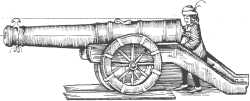The Gun - Smoothbore Era 1550-1860: Sights and Laying | |
Elevation in the Smoothbore EraIn early days the layer had only his judgement to guide him in putting the correct elevation on his piece. Therefore one of the first duties of a No 1 when he took over a gun was to find its 'point blank range', then defined as the range achieved by a shot with the piece laid horizontal. | |
|
In laying by 'line of metal' he was confronted by the 'dispart', ie the difference between the diameters of base ring and muzzle, for it can easily be seen that if he laid the gun with the line of metal horizontal the axis of the bore would be slightly elevated. So he had to measure the dispart by poking a vent pricker down the vent and so measure the distance from the bottom of the bore to the base ring, then measure from the bottom of the bore to the top of the muzzle, and calculate the difference. He could then either make an allowance for the dispart when laying or construct a makeshift foresight and tie it to the muzzle. |
 Makeshift foresight to adjust for 'dispart'. |
| By the 19th century guns were being made with a 'dispart patch' to make the height of the muzzle from the bottom of the bore the same as the height of the base ring. As a further step he could fabricate graduated rods for various ranges. | |
 |
Laying for elevation using rods of different lengths as backsights. |
|
But better things were on the way; around 1545 Tartaglia invented the gunners quadrant. With this instrument plus intensive training in the judging of distance a Number One was able to relate range achieved to elevation on the gun, and thus able to compile a range table of sorts. | |
 |
 |
| Gunners Quadrant in use on a siege gun mounted on a specially prepared level platform. | Alternative form of the Gunners Quadrant in use. |
|
The quadrant was normally used only on the heavier guns for more deliberate shooting, eg during sieges. In field artillery where ranges were comparatively short the No 1 deduced the required elevation from experience. The quadrant remained in use for some three hundred years after its invention. During the latter half of the 18th century some were modified by substituting a spirit level for the plumb line and bob. | |
|
Another means of applying elevation to siege or garrison guns before the introduction of the tangent sight was the use of quarter sight scales. These were cut on either side of the base ring and used in conjunction with notches cut on either side of the muzzle. They enabled up to 3° elevation only to be applied, and were so-named because they were graduated in quarters of a degree. Means of applying more elevation would have been superfluous because at 3° the range of the 24-pr firing roundshot was only 1500 yards, by which time its effectiveness, even against wooden ships, would have been minimal. |
 Showing quarter sight scale (at breech) and notch (at muzzle) for use as foresight on a SBML 24-pr gun of 1813 vintage, once part of the main armament at Fort Britomart, Auckland, until 1873. The appropriate division on the scale, the notch on the muzzle, and the target, were lined up by eye. |
|
WL Ruffell previous | index | next | History index | Home | |